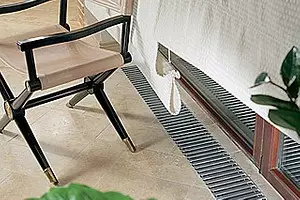
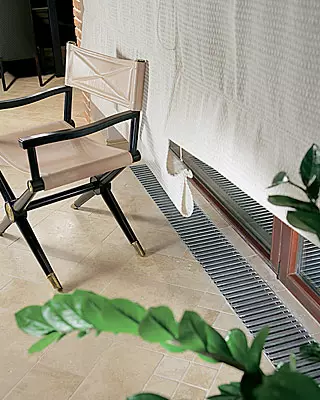
Convectors externally similar to long low boxes with a lid in the form of a decorative lattice. Under the grille, in the housing (it is also called a chute) of the device, the heat exchanger heating air is installed (the tube with the plates strung on it) connected to the heating system. In addition to the heat exchanger in the groove of the convector, one or more small fans with electric motors can be located, which allow you to speed up the heating of the room due to the intensive blowing of the heat exchanger, as well as various regulatory devices.
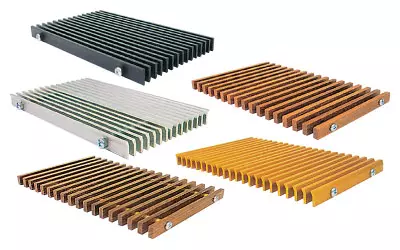
The color of the grille of the embedded convector can be chosen under the color of the floor covering or other important elements of the indoor indoor decoration (for example, curtains). The benefit of the palette of shades, in which the lattices are painted, most producers are offered quite rich. In the manufacture of products, aluminum is usually used (without decoration, anodized or polymer paint), valuable wood rocks (oak, beech, red wood, nut, less often birch) or plastic. (The texture of the floor will emphasize the design of the decorative lattice.) The components of its crossbar can be located across the gutter of the convector - this lattice is similar to the rope staircase, it is very flexible and easily rolled into the bay, which is convenient, say, when cleaning the room. Along the gutter, the crossbars make rigid and semi-rigid aluminum lattices (in the latter the linear elements are bonded with each other with special springs, allowing you to clearly withstand the size and not weighing the design).
Principle of action of non-fantaless embedded convectors (A, B)
and embedded convectors with a low noise tangential fan (B, D)
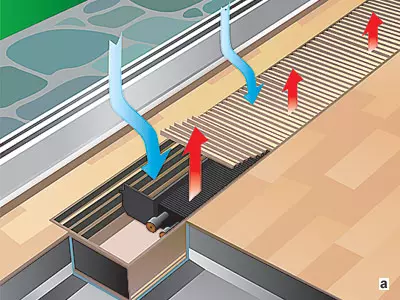
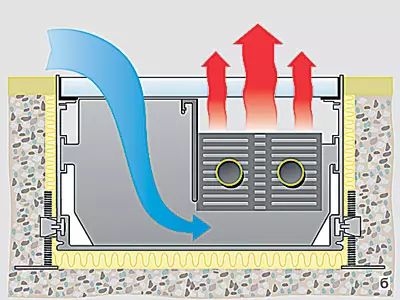
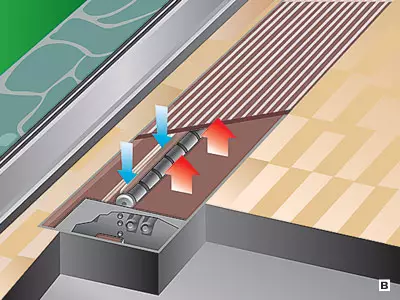
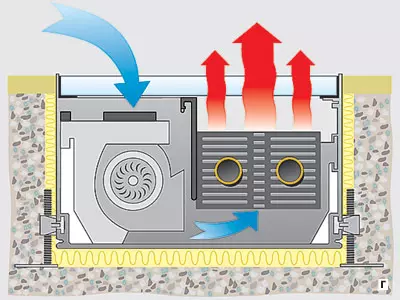
The serial devices are rectangular lattice, dimensions of them once and are forever defined by the manufacturer: the width is from 140 to 430 mm, the length is from 850 to 5000 mm. But if the rectangular configuration and standard equipment dimensions do not suit you, you can order embedded convectors for a specific cottage. The gutter (and respectively lattice) theoretically may have an unlimited length and curvilinear form. It is possible to connect decorative panels on the COP in the corners of the premises (the angle of articulation of the lattices in some manufacturers - only 90o, from others - from 0 to 180o). The gutter can repeat the contours of the curvilinear sites (for example, in erkers), ride columns, etc. Under the order makes lattices with metal inserts, lamps, electrical sockets and other built-in equipment.
From the point of view of performance characteristics, the convectors are built in the floor are good with their low inertia. Due to the minimum volume of hot water contained in them, they almost instantly respond to changing the needs of the room warm, providing high thermal comfort and costs for heating costs.
The front panels in high-quality convectors are heated only to 40-45 ° C, even if the temperature of the coolant in the heating system is high. Therefore, and with a long touch to obtain a burn, it is impossible to obtain a burn (however, it is still not recommended to walk the barefoot in the lattices of heaters). Interior items, including leather sofas, armchairs, or electrical equipment can be placed in close proximity to the convector without danger of damage. Air passing through the device is in contact with only small sections of a strongly heated heat exchanger tube, the total area of which is approximately 3.5-5% of the entire area of the heat exchanger plates heated weaker. Therefore, even at the maximum coolant temperature, the heat exchanger surface has an average temperature of about 60 ° C, which practically eliminates the burning of dust and significantly reduces (compared to other types of heaters) positive air ionization, adversely affecting the health and well-being of a person.
The disadvantages of the embedded devices are a bit, but they are quite substantial. First, the complexity of the plug in the floor design. Secondly, a gradual decrease in heat transfer and noise appearance due to the weakening of contact of the plates of fins with pipes due to corrosion (only soldered copper plates can be avoided). Thirdly, the need for wet cleaning of the floor forces to make special electrical safety measures when using convectors with fans. The best solution is a low voltage power supply 12 or 24 V.
